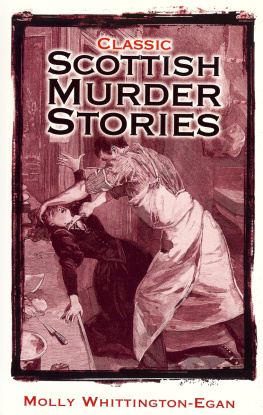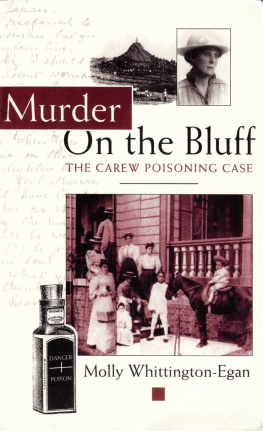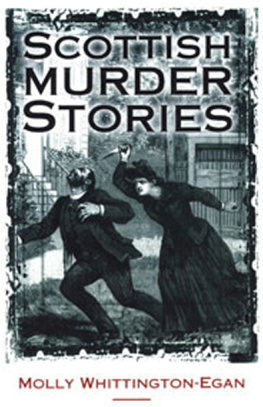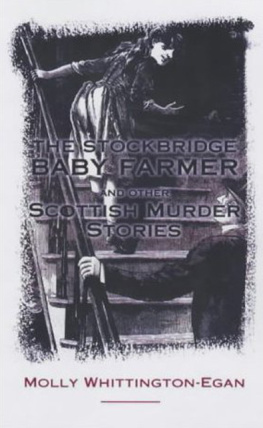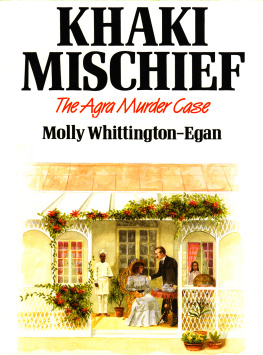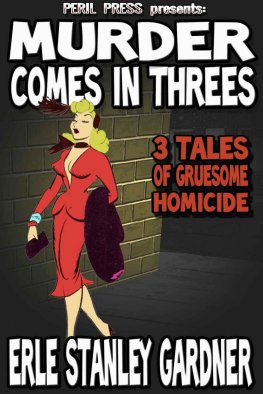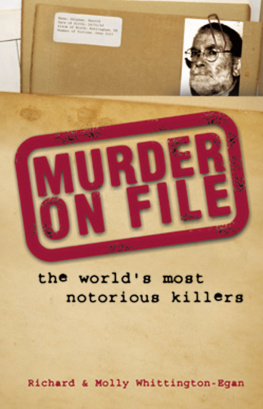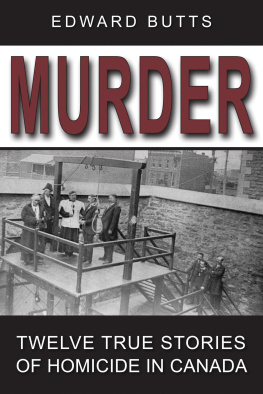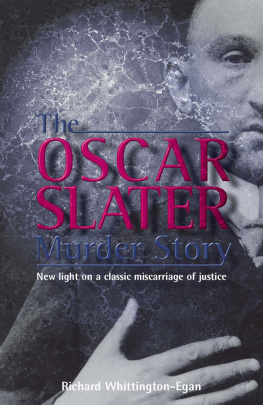
ACKNOWLEDGEMENTS
My special thanks to Hilary Bailey, Glenn Chandler,
Stewart Evans, Max Falconer, Robert Gilbert,
Melvin Harris, Dr Marc Hinchliffe, Carole Hopkins,
John Linklater, Lewis MacDonald, Andy Melbourne,
Jerry Mullaney and Richard Whittington-Egan
CONTENTS
The Misted Mountain
The Arran Case, 1889 |
The German Tea-Planter
The Broughty Ferry Case, 1912 |
The Late Mr Toad
The Musselburgh Case, 1911 |
Oh! Loch Maree!
William Laurie King, 1924 |
The Running Girl
Christina Gilmour, 1843 |
The Travelling Man
Hugh Macleod, 1830 |
The Naked Ghost
Sergeant Davies, 1749 |
The Cinderella Syndrome
Bertie Willox, 1929 |
Holy Willie
William Bennison, 1850 |
A Tryst with Dr Smith
The St Fergus Case, 1853 |
The Wild Geese
The Saunders Case, 1913 |
The French Schoolmasters Wife
Eugne Marie Chantrelle, 1878 |
The Ice-Field
The Arran Stowaways, 1868 |
The Toad in the Tunnel
The Garvie Case, 1968 |
Bible John
The Barrowland Ballroom Killings, 1968-9 |
Jock the Ripper
William Henry Bury, 1889 |
The Quest for Norah
The Fornario Case, 1929 |
The Stockbridge Baby-Farmer
Jessie King, 1888 |
I am Gall
Peter Queen, 1931 |
The Half-Mutchkin
Edinburgh Brothel Case, 1823 |
To the Lighthouse
Robert Dickson, 1960 |
Mr Kellos Sunday Morning Service
John Kello, 1570 |
The Whiteinch Atrocities
The McArthur Murder, 1904. William and Helen Harkness, 1921 |
Death of a Hermit
George Shaw and George Dunn, 1952 |
The Light-Headed Cutty
Mary Smith, 1826 |
The Postman Only Knocked Once
Stanislaw Myszka, 1947 |
Brutality
James Keenan, 1969 |
Rurality
James Robb, 1849 George Christie, 1852 |
The Northfield Mystery
Helen and William Watt, 1756 |
Blue Vitriol
Kate Humphrey, 1830 Anne Inglis, 1795 |
The Battered Bride
John Adam, 1835 |
The Babes in the Quarry
Patrick Higgins, 1911 |
The Poisonous Puddocks
George Thom, 1821 |
The Tram Ride
Alexander Edmonstone, 1909 |
The Tooth-Fiend
Gordon Hay, 1967 |
The Icing on the Shortbread
Thomas Brown, 1906 |
CHAPTER 1
THE MISTED MOUNTAIN
T he essence of the Arran murder lies (to invoke in one breath the song and Wordsworths poem) in the conundrum that two men went to climb, went to climb a mountain, one came down and the other stayed up, rolled round in earths diurnal course with rocks, and stones, and trees.
An act of murder committed high up in the mists so that the island is, as it were, crowned with the old burst of devilry, does produce a special atmosphere. These perceptions are always subjective, but the Isle of Skye, however grand the Cuillins, with their well-remembered peaky silhouette and torrents of scree, seems a kindlier place than the Isle of Arran. Imagine a murder staged under the Cioch, that fine bossed rock, and the whole spirit of the locus would be changed.
Before it happened, just before it happened, an expedition to Arran was, in 1889, the year after Jack the Ripper, a real adventure for a clerkly person from Tooting. Edwin Robert Rose was normally resident in the very stronghold of Pooterdom, deep in the suburbs of south-west London, with their wooded commons and grids of speculative villas.
Here, at Wisset Lodge, Hendham Road, Upper Tooting, with its inspiring view of the red Tudor-style battlements of Springfield, the Surrey County Lunatic Asylum, at the top of the street, Rose lived in comfort and harmony with his father, four sisters and one brother. The mother was missing, presumably dead. Still a bachelor, at 32, he was employed as clerk in the office of James Goodman, builder, of Mostyn Road, Brixton.
He was not at all bad-looking, slight, dark, with deep-set, soulful eyes and a dense moustache. He could have been a doomed young poet of the 1890s, or even, perhaps, the loved special friend of some great Poet Laureate. There was no hint of a girl-friend, and his hobbies were of a manly nature tennis and cricket, walking and running.
That July, at the start of his fortnights summer holiday, he booked in first at the Glenburn Hydropathic, in Rothesay, where, by previous arrangement, he joined his friend, the Reverend Gustavus James Goodman, Minister of the Presbyterian Church at Walker-on-Tyne. The cleric was the son of Roses employer, who, incidentally, knew nothing of the holiday plan. Rose soon made friends with other young men, and, on July 12 th, having joined up with a picnic-party from the Hydro, he took the Clyde steamer Ivanhoe bound for Arran. He was excited, chatty, approachable, released from the office in Brixton, and stimulated by the sky, and the sea and the impact of the scenery.
The conjuncture of killer with victim is always interesting and sometimes instructive. In this case, the life of the clerk should have been safe enough when he struck up a spontaneous holiday acquaintance with a person of lower social class a skilled artisan. Victim approached killer on the Ivanhoe, mistaking him, it was said, for a member of the picnic-party.
John Watson Laurie for that was his real name, although he was going under the alias of John Annandale and had a visiting card to prove it was slightly disreputable, with a touch of form for theft, but not for violence, and his respectable family in Coatbridge were not at all proud of him. On holiday, he was secretive, elusive, determined to conceal the fact that he was a pattern-maker, working at the Atlas Locomotive Works in Springburn, and lodging at 106 North Frederick Street, Glasgow. Snobbery was the background to the unfolding events.
The basically ill-assorted pair got along famously. Rose did most of the talking. Laurie, at 26 somewhat younger than Rose, was fair against the older mans darkness. In physiognomy, he was less refined. Perhaps Rose was drawn to his air of worldliness, a whiff of raffishness, and Laurie appreciated the clerks touch of class. Rose was a natty dresser, always well turned out for the occasion, and his clothes are a part of the picture. His holiday apparel included a chocolate-brown and white striped tennis jacket, and a white serge yachting cap, rakish beyond the general. Laurie, who could not compete with Roses finery, was notoriously vain, and the contrast is thought to have irked him. His best effort was a brown knickerbocker suit and stylish stockings.
At this stage, from any normal vantage point, Rose was at risk only of being a victim of theft. The two chums enjoyed their trip to Arran, and arranged to return the following day for a longer stay. It was the Glasgow Fair week and most rooms were taken, but lodgings of a sort had been found by Laurie at Mrs Esther Walkers, in the village of Invercloy, Brodick. A Mrs Shaw had brought him to her. She could offer them a wooden outhouse, a lie-to attached, but with no access to the main house, and with its own door. There was one bed. Very probably they were genuinely lucky to find this roof over their heads and there was no hidden agenda on either side.

